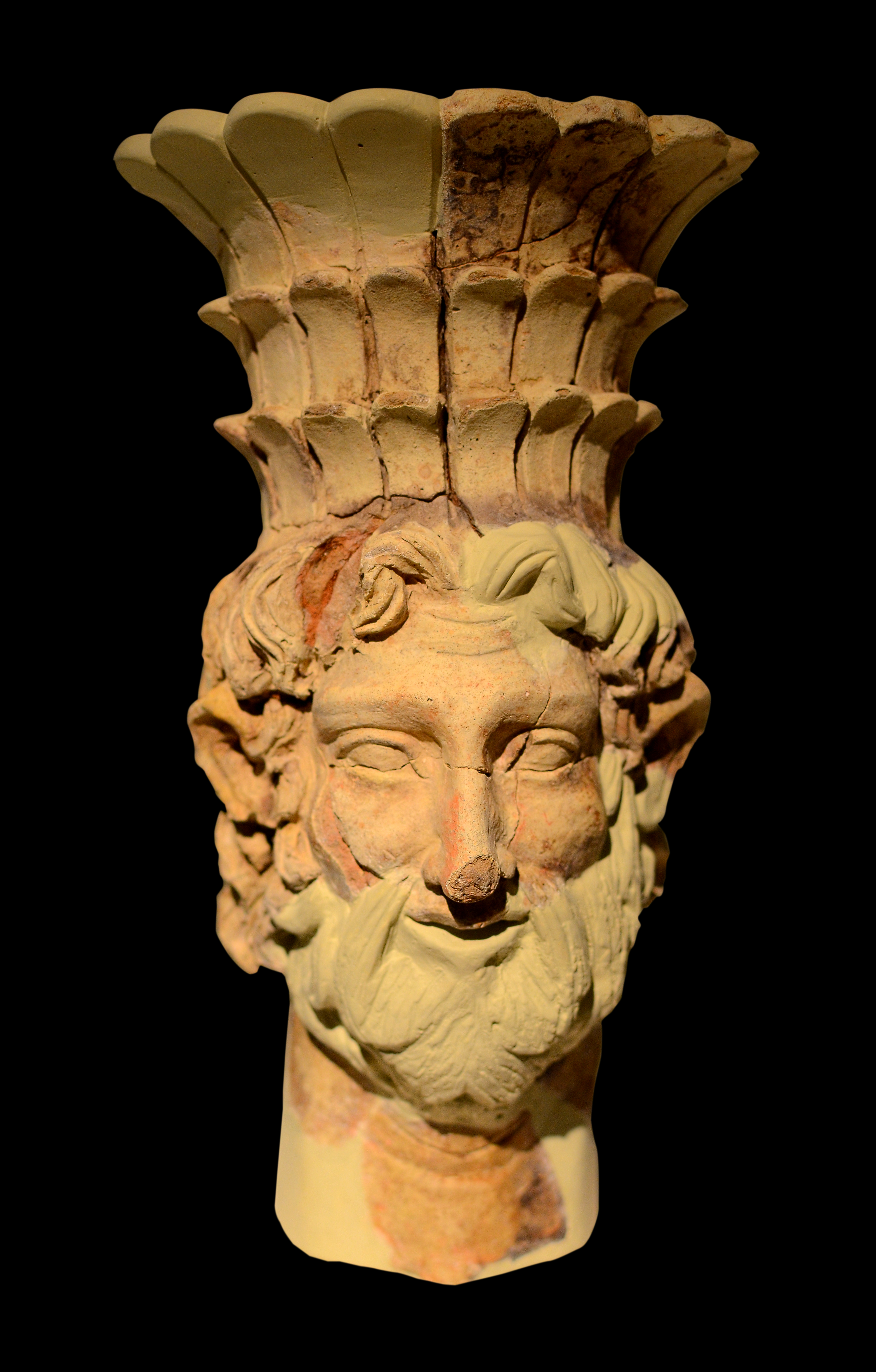Carthage National Museum on:
[Wikipedia]
[Google]
[Amazon]
Carthage National Museum is a national museum in
 The museum was founded in 1875 by Cardinal Charles Martial Lavigerie in the premises of the
The museum was founded in 1875 by Cardinal Charles Martial Lavigerie in the premises of the  The museum is the product of excavations conducted by European archaeologists, in particular those made by Alfred Louis Delattre. The Annex was used at first to house the items found in searches in the necropolis of Carthage and excavations of the St. Louis hill but also Douimès, the hill of Juno, the Sainte-Monique Hill and also the Carthaginian Christian
The museum is the product of excavations conducted by European archaeologists, in particular those made by Alfred Louis Delattre. The Annex was used at first to house the items found in searches in the necropolis of Carthage and excavations of the St. Louis hill but also Douimès, the hill of Juno, the Sainte-Monique Hill and also the Carthaginian Christian
 The various excavations at the site have uncovered numerous items characterizing the Phoenician civilization. The museum contains items which reveal a distinct connection with the
The various excavations at the site have uncovered numerous items characterizing the Phoenician civilization. The museum contains items which reveal a distinct connection with the
 Beautiful
Beautiful
 The terracotta perfume-burner in the form of the head of
The terracotta perfume-burner in the form of the head of
 There are some architectural elements of the Punic city on display, especially fragments of columns and pillars and structures.
Also outlined is a Phoenician inscription on black marble called "registration édilitaire", found in 1954.
There are some architectural elements of the Punic city on display, especially fragments of columns and pillars and structures.
Also outlined is a Phoenician inscription on black marble called "registration édilitaire", found in 1954.
Image:Stèle éléphant musée carthage-v2.jpg, Limestone elephant stele
Image:Stèle palmiers musee carthage.jpg, Stele with palms
Image:Masque et stèles MN Carthage.jpg, Mask and Punic steles
Image:MNC Chapelle cintas-edit.jpg, Part of the furniture in the Cintas chapel, at the topheth
Image:Sarcophage marbre, MNC.jpg, Grand marble sarcophagus
Image:Lampes puniques MNC.jpg, Punic oil lamps
Image:Lampes et ceramiques MNC.jpg, Punic oil lamps and ceramics
Image:Bijoux puniques MN Carthage.jpg, Jewelry
 The history of the Roman city of Carthage begins with a disaster, the will to destroy a rival dating from 146, which has some moving testimonies from the period on showcase. Common items on display are bullets, swords and stone catapults. A skeleton of one of fighters who died violently, is also exposed.
The history of the Roman city of Carthage begins with a disaster, the will to destroy a rival dating from 146, which has some moving testimonies from the period on showcase. Common items on display are bullets, swords and stone catapults. A skeleton of one of fighters who died violently, is also exposed.

 Elements of the official Roman art were discovered on the Byrsa hill, including sculptures and bas reliefs depicting victory. These excavated items have been interpreted as a commemoration of the victory over the Parthians in 166, during the reign of
Elements of the official Roman art were discovered on the Byrsa hill, including sculptures and bas reliefs depicting victory. These excavated items have been interpreted as a commemoration of the victory over the Parthians in 166, during the reign of
Image:Statues romaines MNC Carthage.JPG, Roman funerary statues
Image:Amphore MN Carthage.jpg, Roman amphora
Image:Bas-relief 1 MN Carthage.jpg, Grand relief of the victory
Image:Statue romaine impériale.jpg, Roman Imperial statue
Image:Mosaique MN Carthage femme.jpg, Sidi Ghrib: Rosegarden mosaic
Image:Matrone à sa toilette MNCarthag.jpg, Sidi Ghrib:Matron on the toilet mosaic
 Features of African Christianity at the time, such as ceramic tiles decorated with religious motifs were also excavated and are on display. Many of them are relatively large with decorative details which were intended to depict of the themes of the Old Testament including Daniel and the Lion's Den.
A large number of funerary inscriptions discovered by Alfred Louis Delattre are displayed in the Carthage museum, found during his excavation of the main basilica.
Features of African Christianity at the time, such as ceramic tiles decorated with religious motifs were also excavated and are on display. Many of them are relatively large with decorative details which were intended to depict of the themes of the Old Testament including Daniel and the Lion's Den.
A large number of funerary inscriptions discovered by Alfred Louis Delattre are displayed in the Carthage museum, found during his excavation of the main basilica.
 The famous "Lady of Carthage" mosaic dated back probably to the 6th century, is traditionally regarded as a portrait of a Byzantine empress.Mohamed Yacoub, ''op. cit.'', p. 360 The technique of alternating mosaic tiles and glass tiles, the fineness of the design and elegance of the subject makea it a major piece of art mosaic from the Late Antiquity.
The famous "Lady of Carthage" mosaic dated back probably to the 6th century, is traditionally regarded as a portrait of a Byzantine empress.Mohamed Yacoub, ''op. cit.'', p. 360 The technique of alternating mosaic tiles and glass tiles, the fineness of the design and elegance of the subject makea it a major piece of art mosaic from the Late Antiquity.
Byrsa
Byrsa was a walled citadel above the Phoenician harbour in ancient Carthage, Tunisia, as well as the name of the hill it rested on.
Legend
In Virgil's account of Dido's founding of Carthage, when Dido and her party were encamped at Byrsa, the l ...
, Tunisia
)
, image_map = Tunisia location (orthographic projection).svg
, map_caption = Location of Tunisia in northern Africa
, image_map2 =
, capital = Tunis
, largest_city = capital
, ...
. Along with the Bardo National Museum, it is one of the two main local archaeological museums in the region. The edifice sits atop Byrsa Hill, in the heart of the city of Carthage
Carthage was the capital city of Ancient Carthage, on the eastern side of the Lake of Tunis in what is now Tunisia. Carthage was one of the most important trading hubs of the Ancient Mediterranean and one of the most affluent cities of the cla ...
. Founded in 1875, it houses many archaeological items from the Punic
The Punic people, or western Phoenicians, were a Semitic people in the Western Mediterranean who migrated from Tyre, Phoenicia to North Africa during the Early Iron Age. In modern scholarship, the term ''Punic'' – the Latin equivalent of t ...
era and other periods.
In 1975, excavations exposed a Late Roman house with fragments of Roman mosaics and further off the property was a large church dating to the 5th century. Building plans to create a site museum went into effect in 1983; a year later the museum opened through financial donations from 59 members of a non-profit organization EARTHWATCH. The museum is a collaboration of specialists and volunteers who dedicated their talents and resources to preserve the threatened site of the ancient Mediterranean, Carthage.
The Carthage National Museum is located near the Cathedral of Saint-Louis of Carthage. It allows visitors to appreciate the magnitude of the city during the Punic and Roman
Roman or Romans most often refers to:
*Rome, the capital city of Italy
*Ancient Rome, Roman civilization from 8th century BC to 5th century AD
*Roman people, the people of ancient Rome
*'' Epistle to the Romans'', shortened to ''Romans'', a lette ...
eras. Some of the best pieces found in excavations are limestone
Limestone ( calcium carbonate ) is a type of carbonate sedimentary rock which is the main source of the material lime. It is composed mostly of the minerals calcite and aragonite, which are different crystal forms of . Limestone forms whe ...
/marble carvings, depicting animals, plants and even human sculptures. Of special note is a marble sarcophagus of a priest and priestess from the 3rd century BC, discovered in the necropolis of Carthage. The Museum also has a noted collection of masks and jewelry in cast glass, Roman mosaics including the famous "Lady of Carthage", a vast collection of Roman amphoras. It also contains numerous local items from the period of the Byzantine Empire
The Byzantine Empire, also referred to as the Eastern Roman Empire or Byzantium, was the continuation of the Roman Empire primarily in its eastern provinces during Late Antiquity and the Middle Ages, when its capital city was Constantinopl ...
. Also on display are objects of ivory
Ivory is a hard, white material from the tusks (traditionally from elephants) and teeth of animals, that consists mainly of dentine, one of the physical structures of teeth and tusks. The chemical structure of the teeth and tusks of mammals i ...
.
History of the museum
monastery
A monastery is a building or complex of buildings comprising the domestic quarters and workplaces of monastics, monks or nuns, whether living in communities or alone ( hermits). A monastery generally includes a place reserved for prayer whi ...
; its name until 1956 was the Museum Lavigerie.
basilicas
In Ancient Roman architecture, a basilica is a large public building with multiple functions, typically built alongside the town's forum. The basilica was in the Latin West equivalent to a stoa in the Greek East. The building gave its nam ...
. However, many object unearthed were sold to tourists when the museum had a number of examples of similar objects.
The museum received its present name in 1956 and opened for the first time as a national museum in 1963. It has undergone extensive restructuring in the 1990s, and has now been redesigned to accommodate new discoveries on the site of Carthage, especially the product of searches conducted as part of the international campaign of the UNESCO
The United Nations Educational, Scientific and Cultural Organization is a specialized agency of the United Nations (UN) aimed at promoting world peace and security through international cooperation in education, arts, sciences and culture. It ...
, from 1972-1995.
Punic collections
Phoenician
 The various excavations at the site have uncovered numerous items characterizing the Phoenician civilization. The museum contains items which reveal a distinct connection with the
The various excavations at the site have uncovered numerous items characterizing the Phoenician civilization. The museum contains items which reveal a distinct connection with the Levant
The Levant () is an approximate historical geographical term referring to a large area in the Eastern Mediterranean region of Western Asia. In its narrowest sense, which is in use today in archaeology and other cultural contexts, it is ...
steeped in Egyptian and in particular Greek culture, and the ties of Carthage with Sicily
(man) it, Siciliana (woman)
, population_note =
, population_blank1_title =
, population_blank1 =
, demographics_type1 = Ethnicity
, demographics1_footnotes =
, demographi ...
during the Hellenistic
In Classical antiquity, the Hellenistic period covers the time in Mediterranean history after Classical Greece, between the death of Alexander the Great in 323 BC and the emergence of the Roman Empire, as signified by the Battle of Actium in ...
period. Testimonies to these connections are many objects of pottery
Pottery is the process and the products of forming vessels and other objects with clay and other ceramic materials, which are fired at high temperatures to give them a hard and durable form. Major types include earthenware, stoneware and ...
, oil lamps and amulet s discovered in excavating the necropolis.
The museum has a fine collection of Punic ceramics found from the late 19th century. A number of lamps were found during the excavation of pottery kilns dating back to the Third Punic War
The Third Punic War (149–146 BC) was the third and last of the Punic Wars fought between Carthage and Rome. The war was fought entirely within Carthaginian territory, in modern northern Tunisia. When the Second Punic War ended in 201 ...
.
The amulets of Egyptian deities (Isis
Isis (; ''Ēse''; ; Meroitic: ''Wos'' 'a''or ''Wusa''; Phoenician: 𐤀𐤎, romanized: ʾs) was a major goddess in ancient Egyptian religion whose worship spread throughout the Greco-Roman world. Isis was first mentioned in the Old Kin ...
, Osiris
Osiris (, from Egyptian ''wsjr'', cop, ⲟⲩⲥⲓⲣⲉ , ; Phoenician: 𐤀𐤎𐤓, romanized: ʾsr) is the god of fertility, agriculture, the afterlife, the dead, resurrection, life, and vegetation in ancient Egyptian religion. He wa ...
, Horus, and Bès) indicates the importance of ties between the Phoenicians and the Ancient Egypt, the first retaining these cultural elements once they arrived in the Western Mediterranean.
Funeral objects
 Beautiful
Beautiful sarcophagi
A sarcophagus (plural sarcophagi or sarcophaguses) is a box-like funeral receptacle for a corpse, most commonly carved in stone, and usually displayed above ground, though it may also be buried. The word ''sarcophagus'' comes from the Greek ...
, which are dated to the end of the Punic era, have been found in the necropolis. Among these is the sarcophagus of the priest and the priestess, which is on display in the museum. The priest has the right hand raised in a gesture of blessing
In religion, a blessing (also used to refer to bestowing of such) is the impartation of something with grace, holiness, spiritual redemption, or divine will.
Etymology and Germanic paganism
The modern English language term ''bless'' likely ...
The left hands of the two figures carry vases containing incense
Incense is aromatic biotic material that releases fragrant smoke when burnt. The term is used for either the material or the aroma. Incense is used for aesthetic reasons, religious worship, aromatherapy, meditation, and ceremony. It may also b ...
for liturgical purposes.
Masks of glass also represent numerous deities, including objects which were intended to protect the deceased against the evil eye
The Evil Eye ( grc, ὀφθαλμὸς βάσκανος; grc-koi, ὀφθαλμὸς πονηρός; el, (κακό) μάτι; he, עַיִן הָרָע, ; Romanian: ''Deochi''; it, malocchio; es, mal de ojo; pt, mau-olhado, olho gordo; ar ...
. There are also various items including razor
A razor is a bladed tool primarily used in the removal of body hair through the act of shaving. Kinds of razors include straight razors, safety razors, disposable razors, and electric razors.
While the razor has been in existence since bef ...
s made of bronze and richly decorated with cast patterns, illustrating Egyptian and Greek influences. A number of Punic amulets are also on display.
Punic religion
Ba'al Hammon
Baal Hammon, properly Baʿal Ḥammon or Baʿal Ḥamon ( Phoenician: ; Punic: ), meaning “Lord Hammon”, was the chief god of Carthage. He was a weather god considered responsible for the fertility of vegetation and esteemed as King of ...
was discovered in a sanctuary in the Salammbô quarter unearthed by Dr Louis Carton shortly after World War I.; at the same time diverse other cultural objects came to light, including representations of Demeter
The steles of the topheth are on the other the most important collection that is available. Although stelae were reported in the early research on the site of Carthage, especially during searches of Pricot of Mary (1874), most of which ran with the Magenta
Magenta () is a color that is variously defined as pinkish- purplish- red, reddish-purplish-pink or mauvish-crimson. On color wheels of the RGB (additive) and CMY (subtractive) color models, it is located exactly midway between red and blu ...
'in 1875, many of the most interesting parts are deposited in the museum after the discovery of the sanctuary in 1921 in addition to the most common steles sandstone
Sandstone is a clastic sedimentary rock composed mainly of sand-sized (0.0625 to 2 mm) silicate grains. Sandstones comprise about 20–25% of all sedimentary rocks.
Most sandstone is composed of quartz or feldspar (both silicates ...
's El Haouaria
El Haouaria is a coastal town and commune in the Nabeul Governorate, Tunisia. As of 2004 it had a population of 9,273.
See also
*List of cities in Tunisia
This is the list of 350 cities and towns in Tunisia. In the list by governorate, ...
, steles later limestone subject most often varied scenery: ships, palm trees, elephants and even elements portraits strong Hellenistic influence. Sometimes this is an inscription on the stele. Masks shaped in the form of the head of Ba'al Hammon
Baal Hammon, properly Baʿal Ḥammon or Baʿal Ḥamon ( Phoenician: ; Punic: ), meaning “Lord Hammon”, was the chief god of Carthage. He was a weather god considered responsible for the fertility of vegetation and esteemed as King of ...
are exposed, particularly a large mask discovered by Dr. Louis Carton in the early 20th century.
The content of the "chapel Cintas' discovery topheth by Pierre Cintas in 1947, is the subject of its own window. Two foundation deposits containing mostly ceramics were discovered, one located at the base of a wall and the other called "hideout" was under the floor of a small vaulted room.
Punic architecture
 There are some architectural elements of the Punic city on display, especially fragments of columns and pillars and structures.
Also outlined is a Phoenician inscription on black marble called "registration édilitaire", found in 1954.
There are some architectural elements of the Punic city on display, especially fragments of columns and pillars and structures.
Also outlined is a Phoenician inscription on black marble called "registration édilitaire", found in 1954.
Roman collections
Evidence of the 146 battle: The remains of the siege
 The history of the Roman city of Carthage begins with a disaster, the will to destroy a rival dating from 146, which has some moving testimonies from the period on showcase. Common items on display are bullets, swords and stone catapults. A skeleton of one of fighters who died violently, is also exposed.
The history of the Roman city of Carthage begins with a disaster, the will to destroy a rival dating from 146, which has some moving testimonies from the period on showcase. Common items on display are bullets, swords and stone catapults. A skeleton of one of fighters who died violently, is also exposed.
Roman art

 Elements of the official Roman art were discovered on the Byrsa hill, including sculptures and bas reliefs depicting victory. These excavated items have been interpreted as a commemoration of the victory over the Parthians in 166, during the reign of
Elements of the official Roman art were discovered on the Byrsa hill, including sculptures and bas reliefs depicting victory. These excavated items have been interpreted as a commemoration of the victory over the Parthians in 166, during the reign of Marcus Aurelius
Marcus Aurelius Antoninus (Latin: áːɾkus̠ auɾέːli.us̠ antɔ́ːni.us̠ English: ; 26 April 121 – 17 March 180) was Roman emperor from 161 to 180 AD and a Stoic philosopher. He was the last of the rulers known as the Five Good ...
and presented on a triumphal arch or monument portal.
In addition, works from the reign of Augustus
Caesar Augustus (born Gaius Octavius; 23 September 63 BC – 19 August AD 14), also known as Octavian, was the first Roman emperor; he reigned from 27 BC until his death in AD 14. He is known for being the founder of the Roman Pr ...
are presented including numerous busts. A remarkable representation of Auriga
AURIGA (''Antenna Ultracriogenica Risonante per l'Indagine Gravitazionale Astronomica'') is an ultracryogenic resonant bar gravitational wave detector in Italy. It is at the Laboratori Nazionali di Legnaro of the Istituto Nazionale di Fisica Nuclea ...
, holding a whip and a jug, a symbol of victory, is also exposed. This recent discovery is a valuable testimony to the attention of the Roman circus in the city, which was the second in size after the Circus Maximus
The Circus Maximus (Latin for "largest circus"; Italian: ''Circo Massimo'') is an ancient Roman chariot-racing stadium and mass entertainment venue in Rome, Italy. In the valley between the Aventine and Palatine hills, it was the first and l ...
in Rome.
Mosaics
Although the collections ofmosaic
A mosaic is a pattern or image made of small regular or irregular pieces of colored stone, glass or ceramic, held in place by plaster/mortar, and covering a surface. Mosaics are often used as floor and wall decoration, and were particularly pop ...
s of the museum are not comparable to those of Bardo National Museum, the fact remains that genuine masterpieces are found in the museum. Among the recent discoveries, are from the panels found in a private spa located in Sidi Ghrib, near Tunis
''Tounsi'' french: Tunisois
, population_note =
, population_urban =
, population_metro = 2658816
, population_density_km2 =
, timezone1 = CET
, utc_offset1 ...
. It represents a topless woman running through a rose garden surrounded by water. On the same site a panel of marble and limestone was discovered showing the activity of a matron at the end of the bath. It shows the individual seated on the toilet, surrounded by two servants, one of which holds a mirror and the other carrying a basket with various jewels. At the ends of the mosaic, the artist presents the bath accessories: a pair of sandals, a basket of laundry, a jug, etc.
Christian and Byzantine Collections
Testimonies of Ancient Christianity
The mosaic of the four evangelists discovered in Carthage represents each of the four evangelists. In the center is a sphere in which integrates across
A cross is a geometrical figure consisting of two intersecting lines or bars, usually perpendicular to each other. The lines usually run vertically and horizontally. A cross of oblique lines, in the shape of the Latin letter X, is termed a sa ...
. This work symbolizes the triumph of Christianity
Christianity is an Abrahamic monotheistic religion based on the life and teachings of Jesus of Nazareth. It is the world's largest and most widespread religion with roughly 2.38 billion followers representing one-third of the global pop ...
and its distribution to the four cardinal points by Liliane Ennabli.
Byzantine Civilisation
 The famous "Lady of Carthage" mosaic dated back probably to the 6th century, is traditionally regarded as a portrait of a Byzantine empress.Mohamed Yacoub, ''op. cit.'', p. 360 The technique of alternating mosaic tiles and glass tiles, the fineness of the design and elegance of the subject makea it a major piece of art mosaic from the Late Antiquity.
The famous "Lady of Carthage" mosaic dated back probably to the 6th century, is traditionally regarded as a portrait of a Byzantine empress.Mohamed Yacoub, ''op. cit.'', p. 360 The technique of alternating mosaic tiles and glass tiles, the fineness of the design and elegance of the subject makea it a major piece of art mosaic from the Late Antiquity.
See also
* Carthage Paleo-Christian MuseumReferences
{{authority control Archaeological museums in Tunisia Carthage Phoenician art